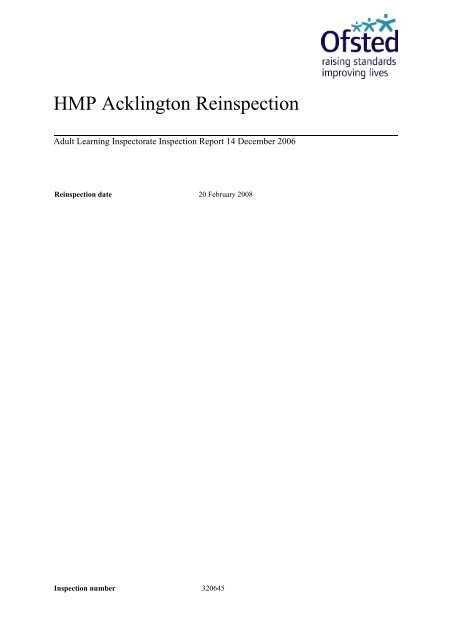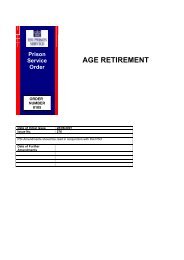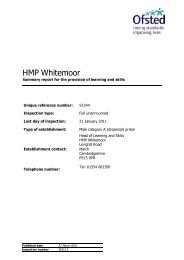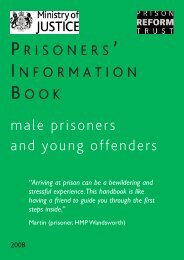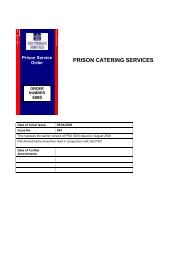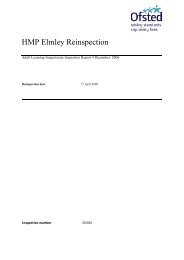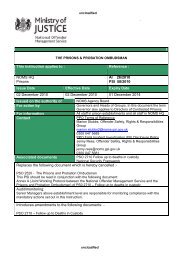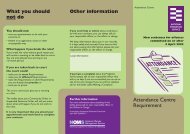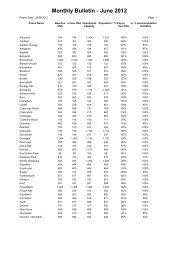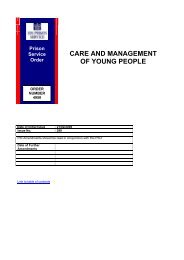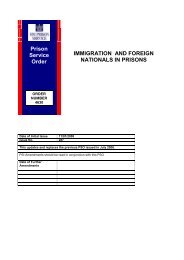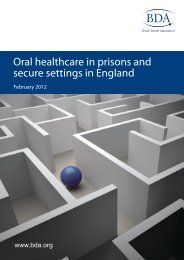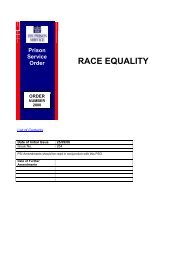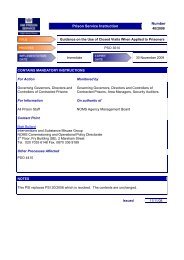HMP Acklington Reinspection - Inside Time
HMP Acklington Reinspection - Inside Time
HMP Acklington Reinspection - Inside Time
- No tags were found...
You also want an ePaper? Increase the reach of your titles
YUMPU automatically turns print PDFs into web optimized ePapers that Google loves.
<strong>Reinspection</strong> report: <strong>HMP</strong> <strong>Acklington</strong> <strong>Reinspection</strong>, 20 February 2008ContentsBackground information ......................................................................................................... 3Description of the provider...................................................................................................... 4Overall effectiveness................................................................................................................. 4Grades ....................................................................................................................................... 5About the reinspection............................................................................................................. 6Achievement and standards and the quality of provision .................................................... 7Leadership and management ................................................................................................ 12Equality of opportunity........................................................................................................ 13
<strong>Reinspection</strong> report: <strong>HMP</strong> <strong>Acklington</strong> <strong>Reinspection</strong>, 20 February 2008 3 of 14Background informationInspection judgementsOverall effectivenessThe grades given for achievement and standards and the quality of provision and leadershipand management will be used to arrive at a judgement about the overall effectiveness of theprovider.Outstanding provision should typically have leadership and management and at least two ofthe three strands within achievement and standards and the quality of provision judged to be agrade 1. All strands within achievement and standards and the quality of provision will begraded 1 or 2.Good provision should have leadership and management and at least two of the three strandswithin achievement and standards and the quality of provision judged to be a grade 2 orbetter. All strands within achievement and standards and the quality of provision will be grade3 or better.Satisfactory provision should have adequate or better grades in leadership and managementand at least two of the strands within achievement and standards and the quality of provisiongrades. An adequate provider might have a range of grades for the strands within achievementand standards and the quality of provision, with no more than one graded 4.Provision will normally be deemed to be inadequate where two or more of strands withinachievement and standards and the quality of provision and/or leadership and management arejudged to be inadequate.Inspectors use a four-point scale to summarise their judgements about the quality of provisionin occupational/curriculum areas and Jobcentre Plus programmes, as well as to summarisetheir judgements about the quality of learning sessions. The same scale is used to describe thequality of leadership and management, which includes equality of opportunity and qualityassurance. The descriptors for the four grades are:Grade 1 – outstandingGrade 2 – goodGrade 3 – satisfactoryGrade 4 – inadequate
<strong>Reinspection</strong> report: <strong>HMP</strong> <strong>Acklington</strong> <strong>Reinspection</strong>, 20 February 2008 4 of 14Description of the provider1. <strong>HMP</strong> <strong>Acklington</strong> is a category C training prison for sentenced adult men. It is the mostnortherly prison in England and opened in 1972.2. The appointed capacity of the prison is 882 offenders segregated over two distinctsections. At the time of the inspection the roll was 860, comprising 391 vulnerableoffenders and 469 main location offenders. Thirty-seven are foreign nationals, 6.7%offenders are from minority ethnic groups. Currently 70% of offenders participate ineducation and training and 184 are unemployed.3. The education contract has been held by Newcastle College (the college) since 2005. Thecollege has a contract to deliver 22,656 hours of learning and skills comprising 19,656teaching hours and 3,000 hours of initial advice and guidance (IAG). Since the previousinspection the volume and range of learning and vocational training has been increasedthrough the colleges’ use of further education (FE) funding from its own budget. Theprison is shortly to open a new 64-bed vulnerable offender unit that will accommodate afurther eight teaching rooms and attract a further 61% increase in LSC funding.4. At the time of the inspection, the head of resettlement managed education and training. Heis supported by an education manager employed by the college and a head of industriesemployed by the prison.Overall effectiveness <strong>Reinspection</strong> Grade 35. The overall effectiveness of the provision is satisfactory. At the previous inspectionachievement and standards and the quality of provision, including literacy, numeracy andlanguage support, and personal and social development, were satisfactory. Employabilityand vocational training were inadequate. The prison’s approach to equality of opportunitywas satisfactory, but leadership and management were inadequate. At the end of thereinspection, all aspects of the provision were satisfactory or better.6. The inspection team was broadly confident in the reliability of the self-assessmentprocess. The self-assessment process includes staff well and draws effectively on a widerange of evidence including course reviews and data. The report is detailed andinformative about each aspect of provision. The report contains a good balance ofevaluative judgements, many of which were similar to the findings of the inspection team.However, some of the self-assessment judgements presented as strengths were judgednormal practice. The self-assessment grades were the same as those awarded by theinspection team in almost all aspects of provision.7. The prison has demonstrated that it is in a good position to make improvements. The earlysigns of improvements identified at the previous inspection have continued. Manyeffective actions have improved the quality and range of provision. Meetings of key workgroups, such as those for resettlement and quality improvement, are held more frequentlythan in the past, to monitor and drive improvements. Many previous strengths have beenmaintained and each area of weakness has improved since the previous inspection. Mostare now at least satisfactory. Where weaknesses remain they are significantly less weighty
<strong>Reinspection</strong> report: <strong>HMP</strong> <strong>Acklington</strong> <strong>Reinspection</strong>, 20 February 2008 5 of 14than previously. Inspection grades have improved by one grade or more in almost everyarea. No areas were inadequate.GradesGrade1= outstanding, Grade 2= good, Grade 3= satisfactory, Grade 4= inadequateGrades awarded at previous inspectionAchievement and standards and the quality of provision 3Contributory grades:Employability and vocational training 4Literacy, numeracy and language support 3Personal and social development 3Leadership and management 4Contributory grades:Equality of opportunity 3Grades awarded at reinspectionAchievement and standards and the quality of provision 2Contributory grades:Employability and vocational training 2Literacy, numeracy and language support 2Personal and social development 3Leadership and management 3Contributory grades:Equality of opportunity 3
<strong>Reinspection</strong> report: <strong>HMP</strong> <strong>Acklington</strong> <strong>Reinspection</strong>, 20 February 2008 6 of 14About the reinspectionNumber of inspectors 2Number of inspection days 8Number of learners interviewed 52Number of staff interviewed 54Number of locations/sites/learning centres visited 1Number of visits to the provider 38. Two inspectors re-inspected the full range of provision in eight days spread over threeseparate visits. The lead inspector conducted two single day monitoring visits inSeptember and November 2007. The final stage of the reinspection took place in February2008.The following strengths and weaknesses were identified during this reinspection:Achievement and standards and the quality of provisionEmployability and vocational trainingStrengthsGood achievementGood attainment of work skillsGood planning and recording of learning outcomesGood developments in vocational and work skills provision for main location offendersWeaknessesInsufficient range of vocational and employability provision for vulnerable offendersLiteracy, numeracy and language supportStrengthsGood achievementMuch good teaching and learningMuch good supportWeaknessesInsufficiently personalised target-setting in many individual learning plansPersonal and social developmentStrengths
<strong>Reinspection</strong> report: <strong>HMP</strong> <strong>Acklington</strong> <strong>Reinspection</strong>, 20 February 2008 7 of 14Good development of personal and social skills in wider learning opportunitiesSuccessful initiatives to provide an offender focused curriculumWeaknessesInsufficient recognition and recording of personal skills developmentLeadership and managementStrengthsMany good actions to improve range and quality of learning and skills provisionGood management of education and prison enterprisesGood links and partnershipsWeaknessesInsufficiently effective activity application procedureInsufficiently effective management of attendance and punctualityAchievement and standards and the qualityof provisionGrade 2Achievement and standards
<strong>Reinspection</strong> report: <strong>HMP</strong> <strong>Acklington</strong> <strong>Reinspection</strong>, 20 February 2008 8 of 14Employability and vocational training9. The good achievement in employability qualifications identified at the previous inspectionhas been maintained. A high proportion of the provision shows good or better successrates. In many courses, success rates are 90-100%.10. Offenders develop useful employability and work skills through their involvement in agood range of activities, courses and programmes. The accountancy and businessenterprise course is particularly beneficial to learners planning to move into selfemploymenton release. Learners gain high skill levels in bricklaying and engineering.The engineering workshop provides an outstanding example of real work activityproducing products for the prison and the external market. The woodwork shop has lost itsoriginal funding but continues to manufacture quality products, such as benches for thelocal council parks. The work ethic and housekeeping across work activities are good.11. Attendance is now monitored and any absenteeism is investigated. However, in someclasses attendance is low and there are a number of vacancies in industries particularly thetailoring workshop.Literacy, numeracy and language support12. Achievement has improved since the previous inspection. Almost all learners whocomplete their programmes achieve their qualification or learning goals. Since August2007 to the date of the reinspection, 83% of learners overall achieved their qualification orlearning goals, 84% in accredited provision and 78% in non-accredited provision.Retention is good. The focus on achievement of qualifications has increased. Learnershave regular weekly access to testing on demand. Most learners make good progress.They show good levels of engagement and concentration in class and make pertinentcontributions during class activities.13. During the inspection, some poor patterns of attendance were noted in sampled classregisters. Classes were late starting on both afternoons of the inspection.Personal and social development14. Overall achievement and retention on personal and social skills courses is satisfactory.Many learners have not yet completed their courses and it is too soon to judgeachievement. However, since August 2007, 37% have achieved and 50% are still inlearning on the creative crafts course. All learners achieved the heartstart first aid unit andpersonal money management course. Success rates on the level 2 open college network(OCN) cookery unit are low. Only four out of the nine learners that started achieved theunit.Teaching, training and learningEmployability and vocational training15. The prison has effectively introduced the use of individual learning plans across alllearning and skills activities. Learners in industries have clear and detailed trainingrecords that document their progress and skill development. An overall learning plan,
<strong>Reinspection</strong> report: <strong>HMP</strong> <strong>Acklington</strong> <strong>Reinspection</strong>, 20 February 2008 9 of 14completed at induction, highlights information about background employment andeducational experience and learners’ aspirations and needs in terms of training andeducation. Tutors and instructors have clear information about levels of literacy, numeracyand any prior achievements. A subject-specific learning plan is developed for eachlearning and skills area that the learner engages in. <strong>Time</strong> bound targets and dates for thereview of progress are set. Learners value the time spent planning their individual targetsand receiving feedback about their progress.Literacy, numeracy and language support16. The good teaching identified at the previous inspection has continued. Teaching is wellplanned and structured. Streaming groups in literacy, numeracy and language haspromoted a more consistent approach to planning for learning. Interaction between tutorsand learners is good. Most teaching is well paced and uses a good range of strategies tomaintain motivation and interest. Tutors check learning frequently. All learners haveindividual learning plans and understand that they have targets. In the best sessions, tutorsmake clear links between individual learning plan targets and the planned outcomes forthe session. Resources are good. All classrooms have interactive whiteboards that all thetutors observed used. Tutors vary in their use of information and learning technology(ILT). In the best session, ILT was used interactively to illustrate concepts, reinforcelearning and engage learners in problem-solving. In other sessions, ILT was used mainlyto share the planned learning outcomes of the session.17. While all learners have individual learning plans, targets are often too tutor centred. Someuse core curriculum targets in their entirety, and are too broad. <strong>Time</strong>scales are not alwaysexplicit. The use of ‘on going’ is commonly used as the target date. In other individuallearning plans, there was clear indication of discussion with learners about their targets,but targets were written from the tutors’ perspective. There is insufficient learnerinvolvement in target-setting in many cases. Clearly written, achievable short and longertermtargets were seen only in a minority of the individual learning plans sampled. Theeducation provider plans to introduce a planned tutorial process to provide more time forsetting targets and reviewing progress.Personal and social development18. The development of offenders’ personal and social skills is a positive outcome of alllearning and skills activities. Learning sessions are well planned and many encouragesocial interaction. Some teachers use group profiles to identify the wider support needs ofindividual learners. Good personal support helps learners to deal with personal barriers.Learning sessions use a range of teaching strategies to promote discussion or group workskills. The wider key skills are well integrated in some subject areas. In one sessionlearners could gain accredited recognition in working with others, problem-solving andimproving own learning and performance. An external exhibition of learners work raisedmoney for charity. Learners in art and bricklaying classes are working on a diversityproject to raise their awareness of disability and access.19. The personal and social skills developed by offenders are insufficiently recognised andrecorded. Group profiles developed by staff highlight some of the personal issues thatoffenders have when they join activities and what they need to do to overcome these.
<strong>Reinspection</strong> report: <strong>HMP</strong> <strong>Acklington</strong> <strong>Reinspection</strong>, 20 February 2008 10 of 14Some individual learning plans identify personal development targets, such as improvingconcentration or increased contribution to discussions. Some learners make significantprogress but this is rarely measured as part of a systematic review of progress.Range of provisionEmployability and vocational training20. Significant improvements have been made in the development of employability andvocational training opportunities. Employment training in 10 areas is available, all ofwhich carry some form of accreditation. Developments to improve progressionopportunities extend the range of levels available. The engineering workshop is in use andbricklaying is available for main location offenders. The new kitchen offers very goodfacilities to expand the number of catering national vocational qualification (NVQ) places.Up to 30 employment places are available where offenders have the option to achieve anNVQ level 1. The new kitchens’ dedicated training area supports progression to level 2.21. All aspects of industries offer good potential for skill development. Further education(FE) and European Social Fund (ESF) funding is used to extend the range of vocationallyrelevant provision, such as bookkeeping, accounting and ITQ level 2. Some recent goodwork in the development of in-cell learning packs supports learning for those on thewings. learndirect provision is now in place. Workshop learning pods provide literacy,numeracy and key skills support. Additional qualifications, for instance in cutting, havebeen introduced into the tailoring area. The prison continues to research and considerother opportunities that focus on employability such as the construction site safety card. Asuccessful initiative to move offenders into the catering industry has provided goodoutcomes.22. There is an insufficient choice of learning and skills provision for the vulnerable offendersthat account for approximately 50% of the prison population. A significant number ofplaces are available in the tailor’s workshop, but some find this work mundane andrepetitive and the work provides limited opportunity for employment on release. Most ofthe activity for vulnerable offenders is in education. They often wait for significantlengths of time to access suitable courses. There is currently no support tutor forvulnerable offenders studying on Open University courses due to long-term sickness.They report that there is still insufficient promotion of learning and skills that was aweakness at the previous inspection.Literacy, numeracy and language support23. The prison has a satisfactory range of provision in literacy and numeracy at level entry 1-3, and levels 1 and 2. Key skills are offered from level 1 to level 3, but numbers arerelatively low in these areas. Much good work has begun to promote essential and keyskills through established vocational provision in the workshops but the impact is notfully established yet. There is some indication that the time allocation for establishedlearning is insufficient to cover the full range of activities. A small, but satisfactory, rangeof provision for speakers of English as a second language (ESOL) meets the needs of thesmall numbers of foreign national offenders with language support needs. The library isactive in promoting reading. The recent introduction of in-cell packs for literacy andnumeracy extends learning opportunities to those who are less motivated to attend
<strong>Reinspection</strong> report: <strong>HMP</strong> <strong>Acklington</strong> <strong>Reinspection</strong>, 20 February 2008 11 of 14education. However, the level of the packs is unclear other than for those linked toaccreditation.Personal and social development24. The curriculum is well designed to meet the offenders’ needs. A good balance ofaccredited and non-accredited courses is delivered to meet the needs of particular groupsof offenders. The pre-release course is modularised and now offers a range of options. Alloffenders are systematically contacted a few weeks before they are due for release toenable them to choose the sessions most pertinent to their needs. The gym programmesoffers a balanced programme to meet the needs of the prisons’ diverse and ageingpopulation. Special provision is in place to help offenders who are over 50 years old tomaintain their fitness. The programme for offenders with mental health problems has beenparticularly successful.Guidance and support25. The prison has met its key challenge to continue to develop the information, advice andguidance (IAG) service well. Matrix accreditation was achieved in February 2007 and theMatrix excellence in prisons award won more recently. The number of qualified IAGworkers has grown to four full time workers. The new 64-bed vulnerable offender wingwill enable the appointment of an additional IAG worker. IAG staff are active on theprison wings and throughout the offender’s sentence from induction onwards. Theircaseloads include a focus on employment at resettlement stage. Offenders who entered theprison after August 2007 benefit from clear and helpful IAG at induction that accuratelyreflects the options they have. Learning champions now provide informal, confidentialguidance in some wings after the education provider used ESF funding to train offenderlearning champions in IAG awareness at level 1. However, it is too soon to judge theeffectiveness of this initiative. An employment mentor is in post until the end of March08. Financial incentives encourage success and completion of targets.26. Since the previous inspection, the focus on pre-release guidance and advice has improved.Staff collectively design and deliver courses based on the needs of offenders, due forrelease, who need help in the re-integration process. For example, ‘back to society’ and‘homeward bound’ sessions helps offenders cope with many of the changes that havetaken place in society since they entered custody.Literacy, numeracy and language support27. Since the previous inspection, the good focus on literacy and numeracy support has beenmaintained. All offenders identified with literacy and numeracy support needs arepromptly allocated support. In class tutor support is good. Tutors are encouraging andmotivating. Learners are treated with respect and they look forward to attendingeducation. Good use of peer mentor support in classes helps less confident or slowerlearners maintain progress. Participant’s with literacy needs benefit from daily readingsupport from their mentors using a nationally recognised system to develop reading skillsMentors attend meetings on the use of this system, supported by the Shannon Trust, andhave very detailed written support guidance, but receive no formal training.
<strong>Reinspection</strong> report: <strong>HMP</strong> <strong>Acklington</strong> <strong>Reinspection</strong>, 20 February 2008 12 of 14Leadership and management Grade 3StrengthsMany good actions to improve range and quality of learning and skills provisionGood management of education and prison enterprisesGood links and partnershipsWeaknessesInsufficiently effective activity application procedureInsufficiently effective management of attendance and punctuality28. The many improvements to the quality of learning and skills provision identified at theprevious inspection have continued and become more established. The prisonimprovement plan and reinspection action plan are actively supported through high levelsof commitment from the prison Governor and head of resettlement. Key groups meetmore frequently now to drive improvement. The recently produced learning and skillsstrategy links clearly to the prison service priority to reduce re-offending. It provides anexplicit focus on ensuring that the promotion and support for learning and skills becomesthe responsibility of all members of staff. New staffing appointments are based oncompetence rather than grade. Investment in resources is good. There are many morelearning opportunities and qualifications than previously. A wide range of 25 in-celllearning packs extend informal learning opportunities and contribute effectively topurposeful activity hours. Planning for re-settlement is much improved and promotesactive choice by learners. Approximately 70% of the prison population are now engagedin purposeful activities. The prison recognises that there is still a shortfall and is exploringmore flexible delivery approaches to maximise opportunities. Communications betweenstaff have improved, but aspects of communication between the prison and offenders areless effective.29. Operational management of education and prison enterprises is good. Good work has beencarried out to improve the sharing of good practice between teams.. Observation ofteaching and learning processes and the use of standardised individual learning plans arein place. There are marked improvements in the accuracy and use of data for target-settingand monitoring progress. Good emphasis on staff development and training supports thedevelopment of new areas. The prison has a good resource of vocational assessors.Effective arrangements are in place to ensure internal verification activity is carried out.The gym now has all the quality systems in place to support it as an approved NVQassessment centre when the refurbishment programme is complete. A high number of staffhave undertaken development to achieve assessor awards to deliver national vocationalawards recognised by employers. There is good joint working between the college and theprison to deliver these awards.30. The good partnership working identified at the previous inspection has continued. Theallocation process is effective, more open and fair, and based on good internal links. Amulti-agency approach includes good offender supervisor and IAG staff contributions inplanning the learning journey. This was a weakness at the previous inspection. Allocationsare based on all available information and learner needs identified in their sentence plan.
<strong>Reinspection</strong> report: <strong>HMP</strong> <strong>Acklington</strong> <strong>Reinspection</strong>, 20 February 2008 13 of 14Good external links have informed many of the initiatives adopted by the prison. Forexample the improved induction process and resettlement programme were adopted fromwork at Durham prison. There are effective links with some prisons that help ensurelearners can complete qualifications if they are transferred. The prison actively works topromote good internal links and joint working through development of a whole prisonapproach in supporting learning and skills. This is at a relatively early stage ofdevelopment. A range of initiatives aim to engage employers at all levels to consideremploying ex-offenders. This was a strength at the previous inspection. No offenders werereleased on temporary licence.31. While the allocation process is good, the system for processing activity applications doesnot ensure that they arrive in a timely manner for the next allocations board. Often there isa delay in receiving them from the wings. There are unnecessary vacancies in activities.32. The management of attendance and punctuality is insufficiently effective There were latestarts on both afternoons in the inspection week. Almost half an hour was lost from thestart of the same subject on each day. Tutors had half an hour to deliver a learning sessionthat they had planned an hour for. Learners report that they sometimes arrive with only afew minutes of learning session left. Some poor patterns of attendance were noted inregisters. Reasons for absences are not always clearly recorded. Tutors are not informedearly enough about reasons for non-attendances. The prison is aware of this and monitorsattendance daily, but it is not clear that punctuality is monitored.Equality of opportunity Contributory grade 333. The prisons arrangements for equality and diversity are satisfactory. There has been muchwork to improve equality and diversity policies in the last 12 months as an integral part ofthe prison improvement plan. Equality and diversity impact assessments are nowcompleted. Data is regularly reviewed to monitor the prison profile and representation ofdifferent groups in various activities. Offenders from minority ethnic groups are wellrepresented in education and at the gym. The race equality officer is full time. A recentprison survey identifies a 10% improvement in offender perceptions about race relations.
<strong>Reinspection</strong> report: <strong>HMP</strong> <strong>Acklington</strong> <strong>Reinspection</strong>, 20 February 2008 14 of 1434. Every wing has access to equality and diversity information packs. However, someinformation is complex. It is not clear what adapted materials are available for the highproportion of offenders with poor literacy skills. The diversity management team meetsregularly and has prison staff and offender representation. The recent establishment of adisability subgroup reflects the needs of an aging population. A small group of volunteeroffenders work as carers for those with disabilities. The allocation process is fair using allavailable information from different agencies. Pay rates are equitable.35. Good links with the Imam support the development of updated equality and diversitytraining for prison staff, but this is not ready for delivery. While all education staff havereceived diversity training, the prison is well below its target with only 39% of prison stafftrained.© Crown copyright 2008Website: www.ofsted.gov.ukThis document may be reproduced in whole or in part for non-commercial educational purposes, provided that theinformation quoted is reproduced without adaptation and the source and date of publication are stated.


